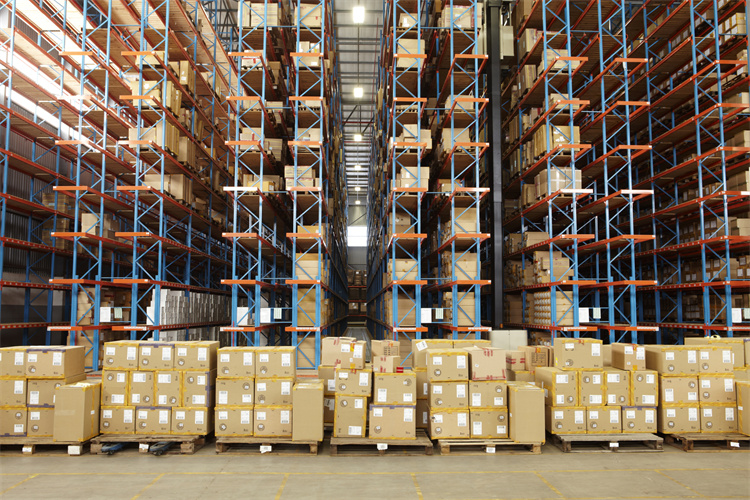From Cost Center to Control Center: Warehouses Are the Heartbeat of Global Supply Chains

Warehouses have undergone a remarkable transformation in recent years. Once seen as static storage spaces, they now serve as dynamic control centers driving efficiency and innovation. This shift reflects the growing complexity of global logistics and supply chain management. Modern warehouses orchestrate operations, optimize inventory, and ensure seamless coordination. For logistics companies, these control centers are essential for meeting rising consumer demands and navigating market challenges. As technology advances, warehouses continue to evolve, becoming the backbone of logistics and a critical asset in achieving operational excellence.
The Strategic Evolution of Warehouses

From Storage Facilities to Control Centers
This evolution stems from the integration of advanced technologies like artificial intelligence (AI) and the Internet of Things (IoT).
For instance, robotic systems now handle tasks such as picking and packing, which minimizes errors and accelerates order fulfillment.
The Role of Warehouses in Optimizing Supply Chain Management
Warehouses are central to achieving supply chain visibility. They provide businesses with the ability to track inventory levels, monitor shipments, and respond to market demands swiftly. This visibility ensures that companies can balance supply and demand effectively, reducing the risk of overstocking or stockouts.
In addition, warehouses contribute to cost reduction by streamlining operations. Advanced warehouse management systems (WMS) allow logistics companies to allocate resources efficiently, minimize waste, and improve productivity. These systems also facilitate better space utilization, ensuring that every square foot of the warehouse serves a purpose.
Moreover, warehouses enhance customer satisfaction by enabling faster delivery times. By strategically locating warehouses near key markets, businesses can reduce transit times and meet consumer expectations for quick shipping. This capability is especially critical for e-commerce companies, where speed and reliability are paramount.
How E-commerce and Globalization Are Redefining Warehousing
The rise of e-commerce and globalization has reshaped the role of warehouses. E-commerce growth has led to an increase in small, frequent orders, requiring warehouses to adapt to high-volume, high-speed operations. Fulfillment centers now process thousands of orders daily, emphasizing the need for automation and real-time data analytics.
Globalization has further expanded the scope of warehousing. Companies must now manage international supply chains, which involve navigating diverse regulations, currencies, and transportation networks. Warehouses serve as critical nodes in this global network, ensuring the smooth flow of goods across borders.
Additionally, the demand for sustainability has influenced warehousing practices. Many facilities now adopt eco-friendly initiatives, such as energy-efficient lighting and renewable energy sources. These efforts not only reduce environmental impact but also align with consumer preferences for sustainable business practices.
"Warehouses are no longer just storage spaces; they are the heartbeat of logistics execution, driving efficiency and innovation in global supply chains."
This strategic evolution highlights the importance of warehouses in modern business operations. By embracing technology and adapting to changing market dynamics, warehouses have become essential for maintaining competitive advantage.
Technology as a Catalyst for Warehouse Transformation

The rapid evolution of technology has revolutionized warehouse operations, transforming them into highly efficient and intelligent hubs. By integrating advanced tools and systems, warehouses now achieve unprecedented levels of productivity, accuracy, and adaptability. This transformation underscores the critical role of technology in modern logistics and supply chain management.
Warehouse Management Systems (WMS) for Operational Excellence
Warehouse management systems (WMS) have become indispensable for achieving operational excellence. These systems provide real-time visibility into inventory and streamline processes, enabling businesses to make informed decisions. By automating routine tasks, WMS reduces human error and enhances accuracy in order fulfillment.
Modern WMS integrates seamlessly with other technologies, such as robotics and IoT devices, to optimize workflows. For instance, automated picking systems guided by WMS ensure precise item selection, minimizing errors and improving efficiency. Additionally, WMS facilitates better space utilization by analyzing data to determine optimal storage layouts. This capability directly impacts a logistics company’s bottom line by reducing costs and maximizing productivity.
IoT and Real-Time Data Analytics in Logistics and Supply Chain Management
The Internet of Things (IoT) has redefined how warehouses operate by enabling real-time tracking and monitoring. IoT devices collect and transmit data from various points within the warehouse, providing actionable insights. This data-driven approach enhances decision-making and ensures smooth operations.
IoT-based systems improve safety and efficiency while reducing waste. For example, sensors monitor equipment performance, alerting managers to potential issues before they escalate. This proactive maintenance reduces downtime and extends the lifespan of machinery. Furthermore, IoT enhances inventory management by providing real-time visibility into stock levels, helping businesses balance supply and demand effectively.
Real-time data analytics complements IoT by processing vast amounts of information quickly. Predictive analytics identifies trends and forecasts demand, allowing warehouses to prepare for fluctuations. This capability ensures that resources are allocated efficiently, reducing overstocking and stockouts. By leveraging IoT and data analytics, warehouses become smarter and more responsive to market dynamics.
Automation and Robotics: The Future of Warehousing
Automation and robotics represent the future of warehousing, driving efficiency and innovation. Robotic systems handle repetitive tasks such as sorting, packing, and palletizing with unmatched speed and precision. This automation reduces reliance on manual labor, lowering operational costs and improving accuracy.
Autonomous vehicles and drones further enhance warehouse capabilities. These technologies streamline transportation within facilities, ensuring timely movement of goods. For instance, autonomous forklifts navigate warehouses safely, transporting items without human intervention. Drones conduct inventory checks, providing real-time data on stock levels and locations.
The integration of robotics with WMS unlocks the full potential of automation. WMS coordinates robotic activities, ensuring seamless workflows and optimal resource utilization. As automation continues to advance, warehouses will achieve new levels of efficiency, positioning themselves as critical assets in logistics and supply chain management.
"Technology is not just a tool; it is the driving force behind the transformation of warehouses into intelligent control centers."
By embracing these technological advancements, businesses can enhance their competitiveness and meet the demands of a rapidly changing market. Warehouses equipped with cutting-edge tools and systems will remain at the forefront of logistics innovation.
Enhancing Efficiency and Value in Supply Chains
Cost Reduction Through Streamlined Operations
Warehouses play a critical role in reducing operational costs for businesses. Labor expenses, which account for 50% to 70% of a warehouse’s budget, represent a significant area for cost-saving opportunities. Automation technologies have emerged as a game-changer in this regard. By automating repetitive tasks such as sorting, picking, and packing, warehouses can reduce labor costs by up to 60%. This shift not only lowers expenses but also enhances reliability in daily operations.
Streamlined operations lead to higher order accuracy and improved order fulfillment accuracy. Advanced warehouse management systems (WMS) optimize workflows, ensuring that every step of the process is efficient. For example, automated picking systems guided by WMS minimize errors, which directly impacts customer satisfaction. Additionally, automation has been shown to increase productivity by 35%, allowing warehouses to handle higher volumes of goods without compromising on speed or quality.
The integration of automation also improves workplace safety. Warehouses that adopt these technologies report a 25% reduction in workplace injuries. This improvement not only protects employees but also reduces costs associated with accidents and downtime. By focusing on operational optimization, businesses can achieve significant cost reductions while maintaining high standards of reliability and efficiency.
Improving Agility and Responsiveness in Logistics Companies
Warehouses equipped with real-time tracking and real-time visibility tools enable businesses to adapt quickly to changing demands.
Strategically located warehouses further enhance speed and responsiveness. By positioning facilities near key markets, businesses can reduce transit times and meet customer expectations for rapid delivery. This approach is particularly valuable for e-commerce companies, where speed is a critical factor in maintaining competitiveness.
Optimization of warehouse operations also contributes to agility. Advanced systems analyze data to predict demand patterns, allowing businesses to prepare for fluctuations. This proactive approach ensures that resources are allocated effectively, reducing the risk of stockouts or overstocking. By improving agility, logistics companies can respond to market dynamics with confidence and reliability.
Sustainability Initiatives in Modern Warehousing
Sustainability has become a priority for modern warehouses. Many facilities now adopt eco-friendly practices to reduce their environmental impact. Energy-efficient lighting, renewable energy sources, and waste reduction programs are common initiatives that align with consumer preferences for sustainable business operations.
By optimizing workflows and reducing errors, warehouses minimize waste and improve resource utilization.
Additionally, some warehouses implement green building designs to further their sustainability goals. Features such as solar panels, rainwater harvesting systems, and natural ventilation reduce energy consumption and promote environmental responsibility. These initiatives demonstrate how warehouses can contribute to a greener future while maintaining high levels of reliability and speed in their operations.
"Sustainability is not just an option; it is a necessity for warehouses aiming to balance efficiency with environmental responsibility."
By embracing sustainable practices, warehouses add value to supply chains and meet the growing demand for eco-conscious solutions. These efforts position businesses as leaders in both logistics and environmental stewardship.
Competitive Advantages of Optimizing Supply Chain Management
Faster Fulfillment and Improved Customer Satisfaction
Optimizing supply chain management enables businesses to achieve faster fulfillment, which directly impacts customer satisfaction. Warehouses equipped with advanced technologies, such as real-time tracking systems, ensure precise inventory management. This capability reduces errors in order processing and guarantees perfectly timed delivery. Customers benefit from faster shipping times, which enhances their trust in the reliability of the service.
For example, Omnimart implemented a SaaS-based warehouse management system (WMS) to gain real-time visibility into their inventory. This upgrade eliminated picking errors and shipment delays, ensuring reliable service for their customers. By streamlining operations, businesses like Omnimart can meet consumer expectations for speed and accuracy, which strengthens their optimizing supply chain management in the market.
Strategically located warehouses also play a vital role in improving delivery times. By positioning facilities near key markets, companies reduce transit times and provide faster, more reliable service. This approach is particularly valuable for e-commerce businesses, where quick delivery is essential for retaining customer loyalty.
Adapting to Market Dynamics with Scalable Warehouse Solutions
Market dynamics constantly evolve, requiring businesses to adapt quickly. Scalable warehouse solutions provide the flexibility needed to respond to these changes. Modern warehouses leverage automation and data-driven insights to adjust operations based on demand fluctuations. This adaptability ensures that businesses maintain efficiency and reliability, even during peak seasons or unexpected disruptions.
K&M Style serves as a prime example of how scalable solutions can transform logistics operations. After implementing a WMS, the company achieved faster picking and receiving times, streamlined workflows, and improved employee onboarding. These enhancements allowed K&M Style to manage a diverse range of SKUs and respond swiftly to changing customer needs. Such flexibility positions businesses to thrive in competitive markets.
Scalable solutions also support long-term growth. As businesses expand, warehouses equipped with advanced systems can handle increased volumes without compromising efficiency. This scalability ensures that companies remain agile and capable of meeting customer demands, regardless of market conditions.
Real-World Examples of Successful Warehouse Transformations
Real-world success stories highlight the transformative power of optimizing supply chain management. For instance, a logistics company implemented a just-in-time inventory system to reduce holding costs and improve cash flow. This approach minimized excess inventory while ensuring that products were available when needed, demonstrating the value of efficient warehouse operations.
Another example comes from Omnimart, which utilized real-time tracking to eliminate shipment delays and improve order accuracy. This transformation not only enhanced operational reliability but also strengthened customer trust. Similarly, K&M Style leveraged advanced warehouse systems to streamline processes and adapt to evolving market demands, showcasing the importance of technology in achieving competitive advantage.
These examples underscore the critical role of warehouses in modern logistics. By adopting innovative solutions and focusing on efficiency, businesses can transform their warehouses into strategic assets that drive growth and enhance logistics efficiency and customer satisfaction.
"Warehouses are no longer just storage spaces; they are dynamic hubs of efficiency and reliability, enabling businesses to stay ahead in a competitive landscape."
Actionable Insights for Businesses
Evaluating Current Warehouse Capabilities
Businesses must begin by assessing their existing warehouse capabilities to identify strengths and weaknesses.
Conducting a needs assessment is equally critical. This process helps logistics companies pinpoint areas requiring improvement, such as outdated equipment or inefficient layouts. By understanding current limitations, businesses can prioritize upgrades that align with their goals. For example, a logistics company might discover that its manual processes hinder order accuracy, prompting the adoption of automation technologies.
Regular performance audits also play a vital role in maintaining operational excellence. These audits measure key performance indicators (KPIs) like order accuracy, fulfillment speed, and labor productivity. Tracking these metrics provides actionable data for refining warehouse strategies and ensuring alignment with customer needs.
Identifying Opportunities for Innovation and Growth
Innovation drives growth in modern warehousing. Businesses should explore emerging technologies like artificial intelligence (AI) and machine learning to enhance predictive analytics. These tools improve demand forecasting, enabling warehouses to prepare for market fluctuations. For example, AI can analyze historical data to predict peak seasons, allowing businesses to allocate resources efficiently.
Automation offers another avenue for innovation. Robotic systems streamline repetitive tasks, reducing labor costs and improving accuracy. Autonomous vehicles and drones further enhance efficiency by optimizing internal transportation and inventory checks. These advancements not only boost productivity but also position warehouses as customer-centric hubs capable of meeting evolving demands.
Sustainability initiatives present additional growth opportunities. Implementing eco-friendly practices, such as energy-efficient lighting and renewable energy sources, aligns with consumer preferences for environmentally responsible businesses. Warehouses adopting these measures can reduce operational costs while enhancing their brand reputation.
Collaboration with industry experts can uncover untapped potential. Engaging with supply chain specialists provides insights into best practices and innovative solutions. For instance, experts emphasize the importance of addressing key risks like transportation disruptions and demand variability. Tackling these challenges proactively ensures that warehouses remain resilient and adaptable.
Building a Roadmap to Transform Warehouses into Control Centers
Transforming a warehouse into a control center requires a strategic roadmap. The first step involves setting clear, measurable objectives. Businesses should define specific outcomes, such as reducing order processing times or achieving 99% inventory accuracy. These goals provide a framework for evaluating progress and ensuring accountability.
Next, companies must invest in advanced technologies. Warehouse management systems (WMS) serve as the backbone of modern operations, offering real-time tracking and seamless integration with other tools.
Training and development programs are essential for equipping staff with the skills needed to manage advanced systems. Employees must understand how to leverage new tools effectively to maximize their impact. Regular training sessions ensure that teams remain proficient and adaptable in a rapidly changing environment.
Finally, businesses should adopt a customer-centric approach. Understanding customer needs and expectations allows warehouses to tailor their operations accordingly. For example, strategically locating facilities near key markets reduces transit times, enhancing customer satisfaction. By prioritizing customer-centric strategies, businesses can transform their warehouses into dynamic control centers that drive value across the supply chain.
"A well-executed warehouse strategy not only improves efficiency but also positions businesses to meet customer needs with precision and reliability."
Warehouses have evolved into pivotal control centers, driving logistics and supply chain management with precision and efficiency. By embracing technology and innovation, businesses unlock the potential for real-time visibility, streamlined operations, and enhanced customer satisfaction. Meeting customer expectations requires logistics companies to adopt advanced tools like real-time tracking and automation. Starting with small, measurable improvements allows businesses to build momentum. Scaling these efforts ensures long-term success in a competitive market. Warehouses, as the backbone of modern logistics, empower businesses to adapt, thrive, and deliver exceptional value.
See Also
Transforming Supply Chain Management With Cloud Solutions
The Future of Logistics Through AI Supply Chains
The Importance of Warehouse Automation for Businesses
